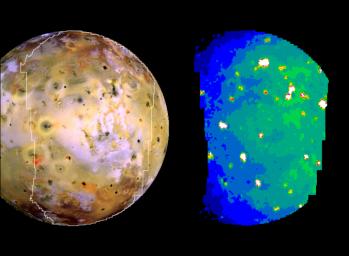
|
Io in Infrared with Giant Plume’s New Hot Spot
- Click the image above for a larger view
- Full-Res JPEG (816 x 600) (59.1 kB)
- Full-Res TIFF (816 x 600) (623.6 kB)
Caption:
Nine previously unknown volcanoes have been discovered from this infrared image of Jupiter's moon Io, acquired by NASA's Galileo spacecraft on Oct. 16, 2001.
The infrared image, on the right, serves as a thermal map to a section of Io's surface from pole to pole. An image from Galileo's camera showing the same face of Io (left) is included for correlating the heat-sensing infrared data with geological features apparent in visible wavelengths. The infrared image uses false color to portray the intensity with which the surface glows at the invisible wavelength of 5 microns, as observed by Galileo's near infrared mapping spectrometer instrument. White, reds and yellows indicate hotter regions; blues are cold. The resolution varies from 24 to 39 kilometers (15 to 24 miles) per picture element.
Some of the hot spots visible in this image were not seen in a similar infrared image taken just 10 weeks earlier of an overlapping section of Io.
Three sites of major activity in the images are Prometheus, which is a bright spot at center left; Amirani, which is an elongated feature in the upper right; and the site where a giant plume was erupting in August, which is the bright spot near the top of the image.
Background Info:
The Jet Propulsion Laboratory, a division of the California Institute of Technology in Pasadena, manages the Galileo mission for NASA's Office of Space Science, Washington, D.C. Additional information about Galileo and its discoveries is available on the Galileo mission home page at http://solarsystem.nasa.gov/galileo/ .
Cataloging Keywords:
| Name | Value | Additional Values |
|---|---|---|
| Target | Io | |
| System | Jupiter | |
| Target Type | Satellite | |
| Mission | Galileo | |
| Instrument Host | Galileo Orbiter | |
| Host Type | Orbiter | |
| Instrument | Near-Infrared Mapping Spectrometer (NIMS) | |
| Detector | ||
| Extra Keywords | Color, Infrared, Map, Plume, Thermal, Volcano | |
| Acquisition Date | ||
| Release Date | 2002-05-28 | |
| Date in Caption | 2001-10-16 | |
| Image Credit | NASA/JPL/University of Arizona | |
| Source | photojournal.jpl.nasa.gov/catalog/PIA03534 | |
| Identifier | PIA03534 | |
